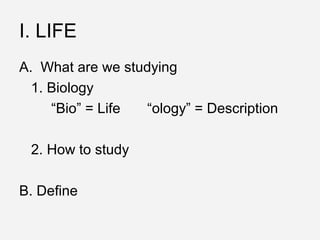
General science
- 1. I. LIFE A. What are we studying 1. Biology “Bio” = Life “ology” = Description 2. How to study B. Define
- 2. C. CHARACTERISTICS C1. Complex, Organized Order Have levels of hierarchy where each level based on and dependent on the ones below. C2. Metabolism Acquire and use energy from the environment
- 3. C3. Homeostasis Maintain a complex structure and internal environment C4. Growth & Development Become larger and more complex. Use material from the environment and incorporate into the body.
- 4. C5. Respond to stimuli Interacts with the environment. C6. Reproduce Make individuals similar to themselves. C7. Evolve Change over time (from generation to generation)
- 5. C8. DNA – Deoxyribonucleic Acid THE HEREDITARY MATERIAL THAT CONTROLS EVERYTHING. Stores information that acts as a blueprint D. HOW STUDY
- 6. E. How to classify life 1. What is used Cell type Cell number Mode of nutrition
- 7. 2. Classification – 3 domains & 4 kingdoms a. Domains BACTERIA ARCHAEA EUKARYA Prokaryote prokaryote eukaryote cell
- 8. b. Kingdoms of Eukarya Eukaryotic cell PROTISTA – single or colony FUNGI – multicellular, consume others, cell wall PLANTAE – multicellular, make food, cell wall ANIMALIA – multicellular, consume others
- 9. II. SCIENCE A. Definition A systematized, mechanistic, causalistic discipline where generalizations to unknowns are determined through observation and experimentation
- 10. B. Characteristics of science B1. CONTROL OF THE UNIVERSE Vitalism Mechanism A vital force (outside the The universe follows the physical realm controls laws of chemistry and the universe). physics (uniform in space and time). Ex. Religion Ex. Science
- 11. B2. PURPOSE OF THE UNIVERSE Teleology Causalism The universe and There is no purpose to events are pre-planned. the universe everything is understood by cause Ex. Religion and effect. (Cause) (Effect) X happens Y happens
- 12. B3. LOGIC Deductive Inductive Generalization Specifics Specifics Generalization CAN’T PROVE TRUE Ex. Math Religion Ex. Science
- 13. III. TWO SCIENTIFIC APPROACHES A. Discovery Science 1. Make verifiable observations and measurements to describe life 2. Completely based on inductive reasoning.
- 14. B. Hypothesis-Driven Science 1. Use scientific method to ask questions 2. Do experiments 3. Use deductive logic to test hypothesis.
- 15. C. SCIENTIFIC METHOD Observation Question Hypothesis Prediction Experiment and Conrol Evluate results Publish Theory
- 16. METHOD OBSERVATION Definition Use senses Example: Bacteria does not grow 1920’s Fleming around fungus.
- 17. METHOD QUESTION Definition What is the cause? Example: How is the fungus killing the bacteria?
- 18. METHOD HYPOTHESIS Definition Testable statement with one variable that proposes an explanation for observations Example: The fungus produces a chemical that kills the bacteria.
- 19. METHOD PREDICTION Definition What you think will happen. Example: If I isolate material produced I will find a chemical.
- 20. METHOD EXPERIMENT CONTROL Test the hypothesis Same as experiment but with only one variable without the variable Heat broth/fungus Heat broth/ no fungus Filter Filter Pour on bacteria Pour on bacteria BACTERIA DIE BACTERIA LIVE
- 21. METHOD EVALUATE Definition What you think results mean. Example: A chemical produced by the fungus kills the bacteria.
- 22. METHOD PUBLISH Definition Communicate with scientific community. Example: Peer review.
- 23. METHOD THEORY Definition A general explanation of natural phenomena. A theory has been tested and upheld many times. THIS IS NOT A SIMPLE IDEA BUT A FUNDAMENTAL PRINCIPLE.
- 24. IV. LEVELS OF COMPLEXITY Chemical atoms, compounds Cellular organelles, cells Tissue cells & cell products that work together
- 25. Organ Tissues that work together and have a genetic shape. System Group of organs that work together for a function. Organism Individual
- 26. Population Local group of individuals that are reproductively isolated Community Group of populations that live close enough to interact Ecosystem Group of communities and related abiotic
- 27. V. MODERN SCIENTISTS A. Linnaeus – classification & taxonomy B. Schleiden & Schwann – Cell Theory C. Charles Darwin – Theory of Evolution D. Gregor Mendel - Genetics